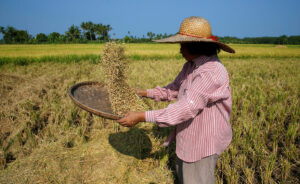By Adrian H. Halili, Reporter
OUTPUT of palay, or unmilled rice, declined to a four-year low of 19.09 million metric tons (MMT) in 2024, the Philippine Statistics Authority (PSA) reported, citing preliminary data.
The PSA said that palay output dropped 4.84% from 2023, the weakest production since the 19.29 MMT reported in 2020.
Full-year rice output came in under the Department of Agriculture’s (DA) 19.3 MMT revised estimate for 2024.
The PSA added that the harvest from irrigated areas was 14.56 MMT, down 4.71%, while palay production in rainfed areas fell 5.23% to 4.53 MMT.
The region with the top palay production was Central Luzon with 3.48 MMT, followed by the Cagayan Valley with 2.92 MMT and the Ilocos Region with 1.97 MMT.
Rounding out the top five rice producers were the Western Visayas with 1.89 MMT and Soccsksargen with 1.21 MMT.
Agriculture was negatively impacted by dry spells and droughts caused by El Niño in the first half, and heavy rains and typhoons in the latter part of 2024, analysts said.
“I expected it to be a bit lower given the series of typhoons in the fourth quarter,” Federation of Free Farmers National Manager Raul Q. Montemayor said via Viber.
“In any case, output already dropped by 5.5% in the first semester mainly due to El Niño and was projected also to drop in the second semester due to La Niña,” he added.
Agricultural damage caused by El Niño was estimated at P15.3 billion on lost volume of 330,717 MT, across 109,481 hectares of farmland, according to the DA’s final estimate. Damage to the rice crop was 38.8% of the total, or P5.93 billion.
Mr. Montemayor said that the 970,000 MT drop in rice production is equivalent to about 15 days’ national consumption.
He added that the lost rice output for the year was offset by a big bump in imports.
The Philippines imported a record 4.78 MMT of rice in 2024, according to the Bureau of Plant Industry.
“Production in 2025 will simply have to try to recover but potentially large imports at low tariffs may dampen farmgate prices and incentives for farmers to intensify production,” he said.
Earlier, the Agriculture department said that it is targeting palay output of 20.46 MMT this year, which could be fulfilled with P10 billion in additional funding for its National Rice Program.
Samahang Industriya ng Agrikultura Executive Director Jayson H. Cainglet said that better farmgate prices for palay could also encourage more rice farmers to continue planting.
“We are hoping for a good harvest starting at end of February or March, so that our rice farmers can earn money … The dark side of an unlimited import policy, via Executive Order (EO) 62, is the tendency to depress farmgate prices across commodities,” Mr. Cainglet said via Viber.
Tariffs on imported rice were slashed to 15% from 35% previously until 2028, through EO 62 which was signed by President Ferdinand R. Marcos, Jr. in June.
He added that the DA and the National Food Authority should increase palay procurement funds to influence the prices paid by millers and traders.






